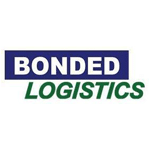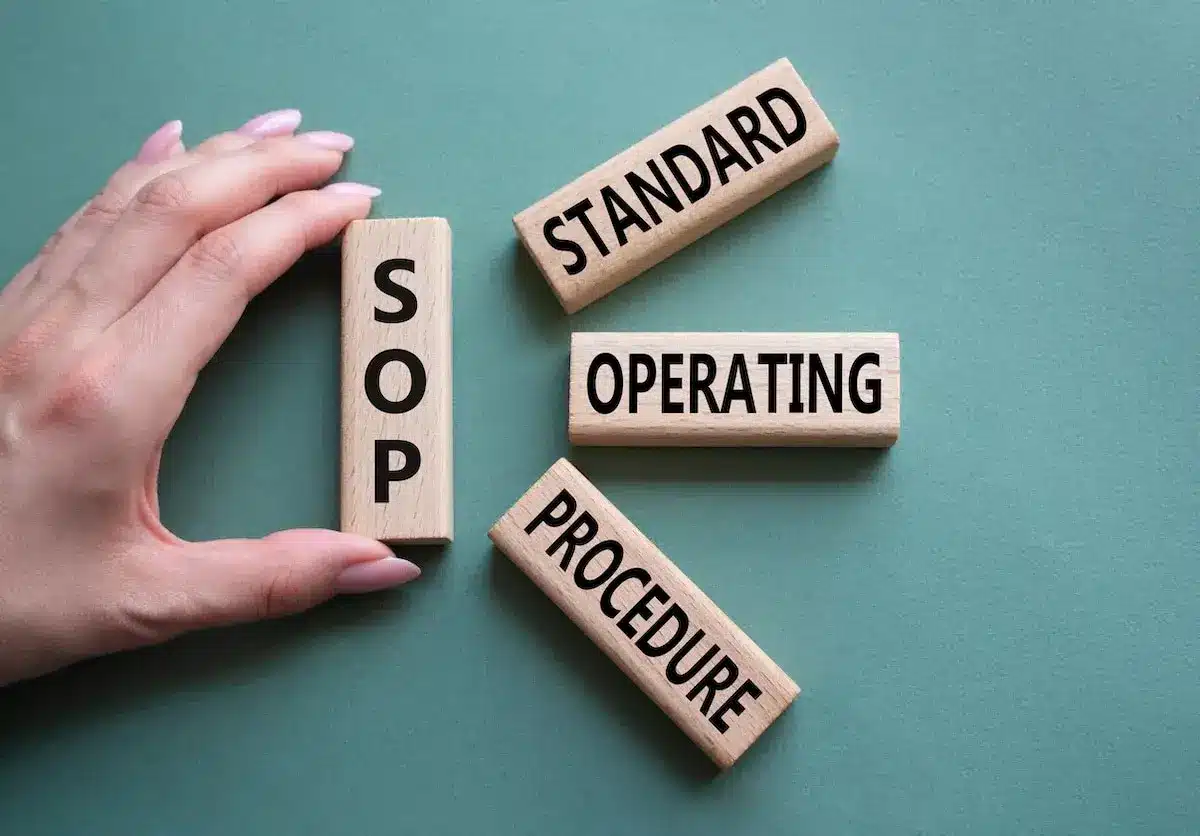Warehouse Layout and Design: Tips for an Efficient and Optimized Operation
A well-designed and efficiently organized warehouse is key to a successful and smooth-running supply chain operation. When it comes to warehouse layout and design, there are many things to consider in order to create the most efficient space possible. In this blog post, we will discuss some of the most important tips for designing a warehouse that operates at peak efficiency.
We will also take a look at some common warehouse layouts and how to improve your current warehouse design. We’ll talk about some of the must-have equipment for any warehouse operation.
And finally, we’ll introduce you to Cadre Technologies – a leading provider of warehouse management software solutions. Our software provides visibility and features to improve warehouse layout and design while optimizing your performance.
So without further ado, let’s get started!
Before we get too far into this topic, let’s briefly answer the question: “What is a warehouse layout?” A warehouse layout is the physical arrangement of all the different sections that make up a warehouse, such as receiving and shipping areas, storage areas, material handling equipment, racks, and workstations. The goal of an effective warehouse layout is to maximize space utilization while providing an efficient flow of goods through the facility from receiving products through picking and shipping orders.
Why is Warehouse Layout Design Important?
Warehouse layout and design is important for many reasons. It helps to optimize the use of space within a warehouse, which in turn increases productivity. Designing an efficient warehouse also helps you make the most of your budget, as it reduces unnecessary spending on materials or equipment that may not be necessary. And maybe even reduces the need for more buildings and space.
In addition, having an efficient layout makes it easier to keep the warehouse clean, which can help prevent accidents and reduce the risk of fires. Finally, a well-planned warehouse layout allows for improved management of inventory, personnel, and processes.
What is Warehouse Optimization?
Warehouse optimization is the practice of utilizing warehouse space, resources, and personnel in the most efficient way possible. This includes streamlining workflow processes, introducing automation where possible, utilizing warehouse management software to track inventory and operations in real-time, and introducing safety protocols or other measures. Sometimes referred to as slotting.
By following best practices for warehouse layout and design and leveraging the right tools, you can optimize your warehouse for improved overall operation. This will help you increase productivity and minimize costs while keeping customers happy.
Make sure to keep up-to-date on warehouse regulations and safety requirements so you can provide a safe and efficient warehouse environment. With the right setup and design in place, you can be sure that your warehouse is running as smoothly as possible.
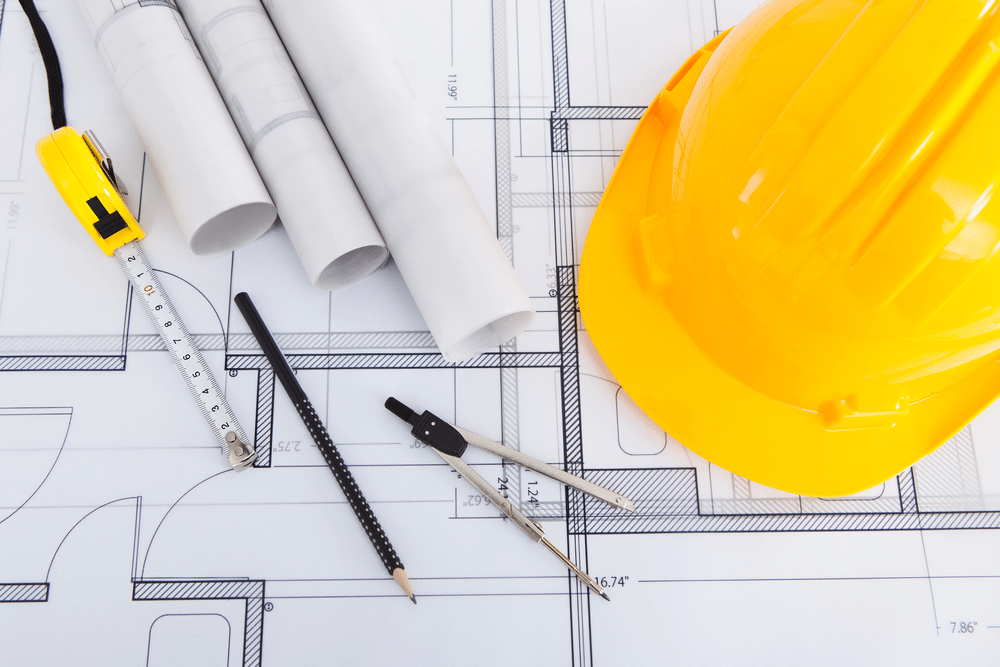
How Do You Organize a Warehouse Layout?
Organizing an ideal warehouse layout requires taking into account all operations that take place in the warehouse. Factors such as access to goods and equipment, space utilization, automation, safety protocols, and warehouse management software should be taken into consideration when designing a warehouse.
When making changes to the layout of your warehouse, make sure to maintain workflow efficiency while also catering to the demands of the supply chain business.
Utilizing warehouse management software can help you monitor operations and track inventory in real-time, so you can easily identify areas for improvement.
The Five Key Areas of a Warehouse Space
When it comes to designing a warehouse, there are five key areas that you should consider – the receiving area, dynamic storage area, static storage area, staging area, and shipping area. Let’s take a look at each of these areas in detail:
Receiving Area:
The receiving area is where goods are received and unloaded from delivery vehicles. This area should be well-organized and have plenty of unloading space. It should also be designed to accommodate the necessary equipment and personnel to handle the unloading process quickly and efficiently.
Dynamic Storage:
Dynamic storage is used for storing items that need to move fairly quickly through the warehouse, such as stock replenishment or fast-moving consumer goods (FMCG). It’s important to ensure that the dynamic storage area is well-organized and easily accessible. Fast pick, home locations provide outstanding productivity if designed and used properly.
Static Storage:
Static storage is used for storing goods that don’t need to move quickly through the warehouse, such as bulk items or slow-moving consumer goods (SMCG). The static storage area should be designed with ample space to store large quantities of goods while still providing easy access. And bulk storage is used to replenish dynamic storage areas.
Staging Area:
The staging area is where goods are stored and organized prior to shipment. It’s important to ensure that the staging area has ample space for all of the necessary items, as well as adequate lighting and personnel for efficient loading.
Shipping Area:
The shipping area is where goods are packaged and loaded onto delivery vehicles. This area should be well organized and have the necessary equipment and packing stations to handle the loading process quickly and efficiently.
Other Important Areas Within a Warehouse
In addition to these five key areas, there are a few other important areas that should be taken into consideration when designing a warehouse. These include office space, break room space, and restroom facilities.
Office Space
Office space is needed for administrative tasks such as paperwork, data entry, and scheduling. It’s important to make sure you have enough office space to accommodate all the necessary staff, desks, filing cabinets, and storage.
Break Room Space
Breakroom space should be provided for warehouse employees to take their breaks, eat meals, and relax. This area should be comfortable and contain all the necessary amenities, such as tables, chairs, microwaves, and fridges.
Restroom Facilities
Restroom facilities are essential to any workplace and should be provided for employees to use while they are on the job. These should be clean, hygienic, and well-maintained.
Common Warehouse Layouts
When it comes to warehouse layout designs, there are three common designs that you should consider – U-shaped, I-shaped, and L-shaped. Each of these layouts has its own advantages and disadvantages.
U-Shaped Warehouse Layout:
The U-shaped warehouse layout is the most common type of warehouse design and is popular for a number of reasons. This layout utilizes a semi-circular “U” shape with the receiving area on one end and the shipping area on the other. This layout is efficient and works well to separate areas for both incoming and outgoing goods. It also provides easy access to each area, making it ideal for small warehouses.
A potential downside to the U-shaped warehouse layout is that it can be difficult to expand if needed. For larger warehouses, this may not be ideal due to the limited expansion options.
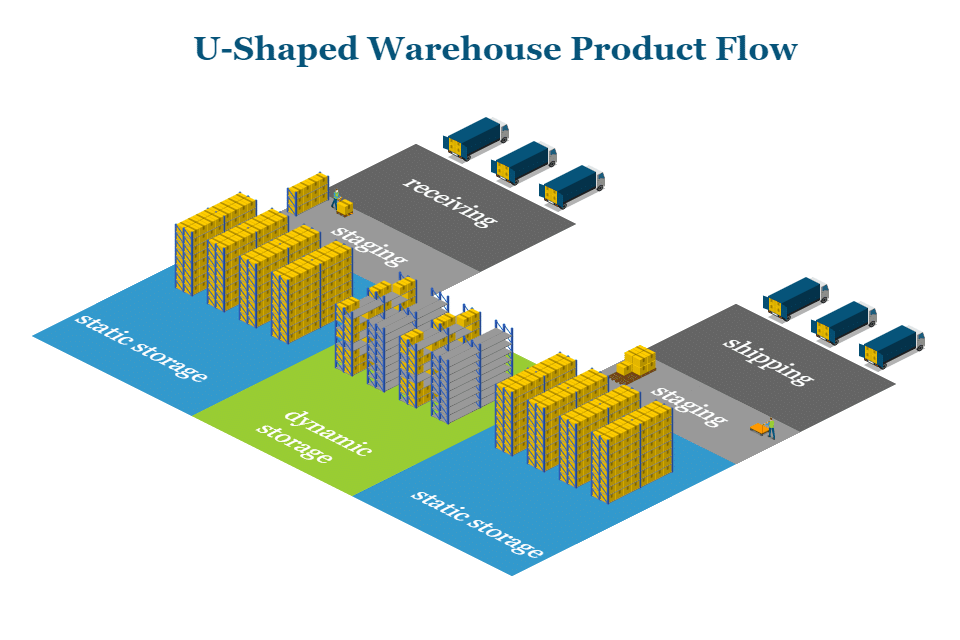
I-Shaped Warehouse Layout:
The I-shaped warehouse layout utilizes a long, linear shape with the receiving area at one end and the shipping area at the other. This layout is commonly used by large warehouses due to the efficient use of floor space. It’s also ideal for storing and processing large quantities of goods, as it allows for adequate loading and shipping areas.
A downside to this layout is that complete loading and unloading areas are needed on opposite sides of the warehouse. This can make it difficult to access the entire warehouse from one location. It also means goods must travel the entire length of the warehouse for loading and unloading, which can be inefficient.
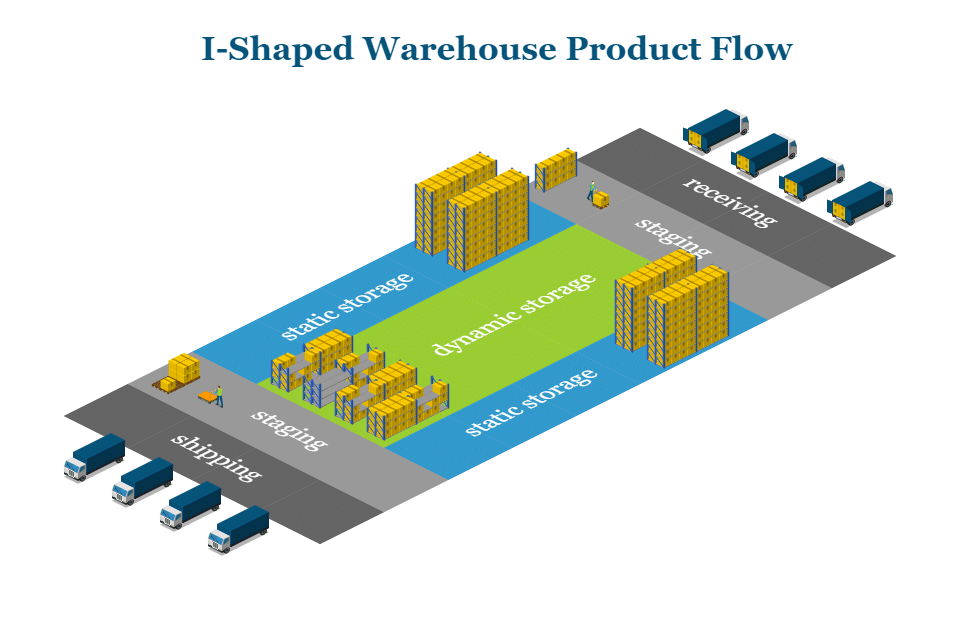
L-Shaped Warehouse Layout:
The L-shaped warehouse layout combines aspects of both the U-shaped and I-shaped layouts. This layout utilizes an L-shape with the goods receiving area on one side and the shipping area located at the other far end. This allows for efficient storage and organization of goods, as well as easy accessibility to both the receiving and shipping areas.
However, this warehouse layout is less common than the other two. It is typically only used when the building structure is in an L-shape or when the warehouse needs to be divided into multiple sections.
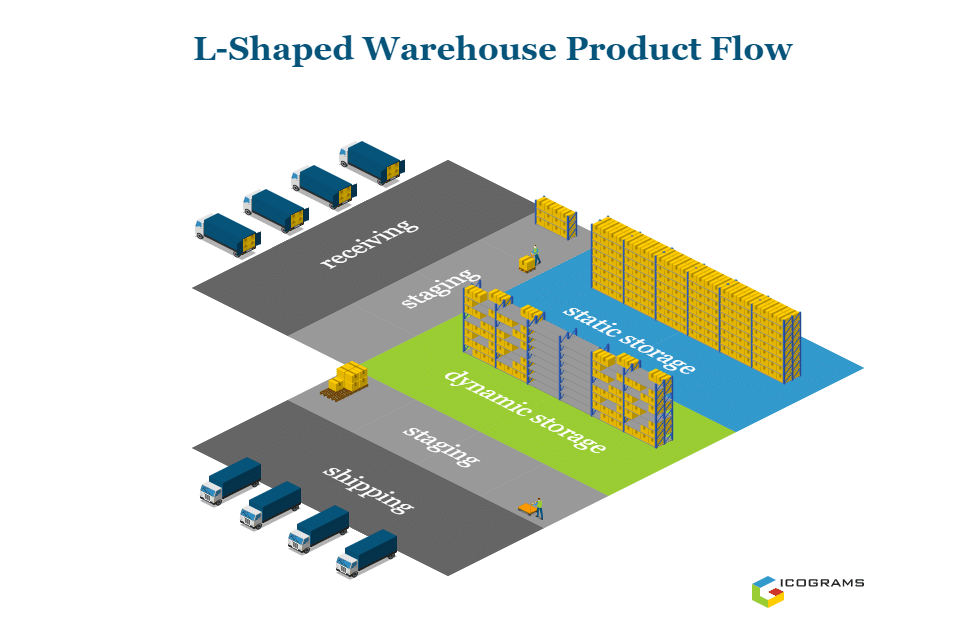
Important Things to Consider When Designing Your Warehouse Layout
When designing an efficient warehouse layout design, it’s important to keep several key factors in mind. These include storage & inventory, the inbound receiving dock, picking and packing areas, the outbound shipping dock, and employee space.
Storage & Inventory
One key factor is that the storage and inventory area should be designed with enough space to store all of the goods coming in and out of the warehouse. This area should be easily accessible and well organized for efficient stock management.
Inbound Receiving Dock
The inbound receiving dock is where goods are received when they come in from suppliers or customers. This area should be spacious enough to accommodate the required number of vehicles at the same time, as well as have enough room for workers to process and store the goods.
Picking and Packing Areas
The picking and packing areas should be designed for quick and efficient item retrieval. These areas should have the necessary equipment, such as conveyor belts, to facilitate the type of picking process used by your supply chain business.
There are a number of different picking methods used in warehouses today. Which one you use can affect the requirements of your warehouse layout design. A few of these methods include:
Discrete Picking: This is where individual orders are picked separately one at a time.
Batch Picking: This is a method where multiple orders are grouped together and picked simultaneously.
Zone Picking: This is a combination of discrete and batch picking, whereby items for multiple orders are grouped together in ‘zones’ and picked from those zones.
Wave Picking: This is a picking method where orders are grouped together based on their due date and then picked in order of the earliest dates first.
Outbound Shipping Dock
The outbound shipping dock is where goods are prepared for delivery. It’s important to design this area with enough space to accommodate all of the necessary items, as well as adequate lighting and personnel for efficient loading.
Employee Space
As we’ve mentioned earlier, you’ll need to plan additional spaces for office space, break room space, and restroom facilities. Additionally, you should also consider providing adequate storage solutions for personnel to store their personal items while they are at work. An office is necessary to carry out administrative tasks. While breakroom space and restroom facilities should be designed to ensure employee comfort.
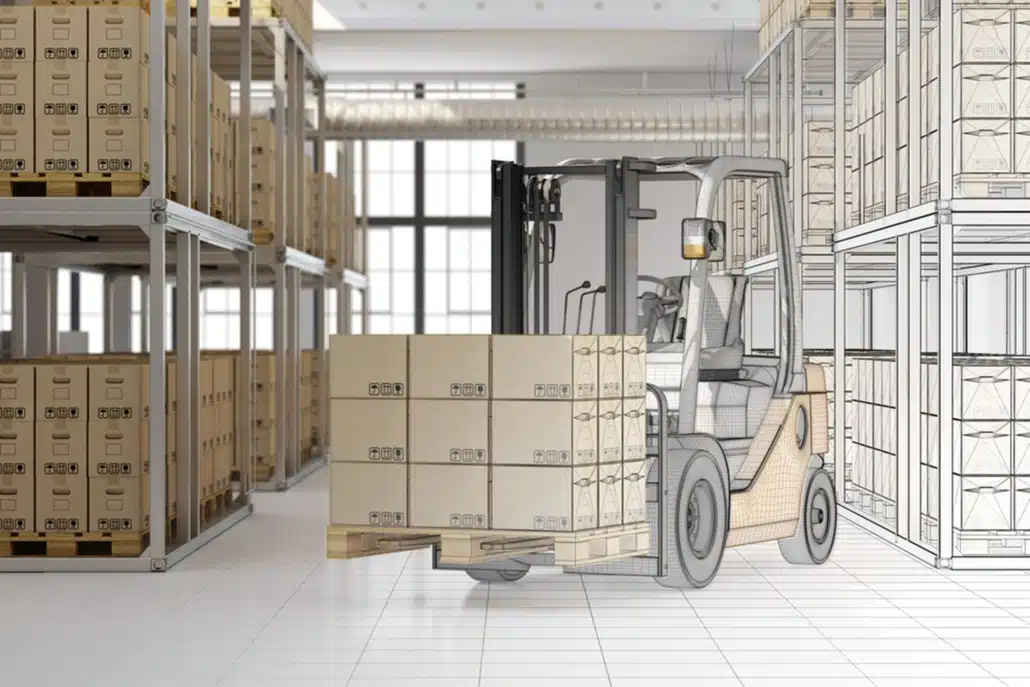
Warehouse Layout Design and Equipment
Another important layout consideration is the type of equipment used in the warehouse. Depending on your operations, you may need a variety of equipment for efficient and optimized warehousing operations. This includes items such as forklifts, pallet jacks, mobile RF scanners, conveyor belts, and more.
Additionally, it is important to consider racking and shelving solutions for efficient storage and organization of goods.
Large Equipment
If large equipment such as conveyors are used in the warehouse, it is important to ensure that there is sufficient space allocated for them. The layout should also accommodate adequate aisle space for personnel to navigate safely around large machinery such as forklifts, rolling stairs, or pallet jacks.
Racking and Shelving
When it comes to racking and shelving, it is important to choose the right type depending on the size and weight of the material stored. Shelving is used to store goods that are stacked by hand. This includes plastic boxes, bins, or other containers.
Racks and pallet racks, on the other hand, are typically used to store heavier goods that require equipment such as a forklift for retrieval. A pallet rack is designed to safely and efficiently store and organize pallets of goods. The lower level of pallet racks may also be suitable for storing goods that need to be picked by hand.
Warehouse Safety
In addition to the layout and operational equipment, it is important to consider warehouse safety. This includes ensuring proper ventilation, lighting, and ergonomic design in the warehouse. Ensure that you incorporate safety equipment such as fire extinguishers, first-aid kits, emergency exits, and signs at key locations in the warehouse.
Additionally, installing security cameras and other anti-theft measures is important for safeguarding goods and personnel.
Tips for Optimizing Warehouse Layout Design:
No matter what type of warehouse layout design you choose, there are a few tips that can help optimize your operation.
- Map it All Out: Before you start making changes, it is important to map out the warehouse floor plan and its existing layout. This design process will give you a good starting point for planning changes. This can be done on paper, with an official warehouse blueprint, or with software such as Cadre Technologies’ WMS™.
- Plan for Space Optimization: When planning a warehouse layout design, it’s important to plan for efficient space usage. For example, make sure that you are not leaving too much space between shelves and racks, or leaving too much empty space around machinery.
- Choose the Flow that Makes the Best Use of Your Space: The layout should also be designed to accommodate the flow of goods from receiving, through storage and picking, to shipping. This will help ensure efficient loading and unloading, as well as the movement of goods and personnel throughout the warehouse.
- Choose the Right Equipment: Choose equipment that is best suited for your operations. This includes items such as forklifts, pallet jacks, RFID readers, conveyor belts, and more. Additionally, make sure to choose the right shelving and racking solutions for efficient storage and organization of goods.
- Test and Record the Results: After you have designed your warehouse layout design, it is important to test it out and record the results. This will help you identify any potential bottlenecks or areas that need to be improved. Also, by regularly testing and recording data, you can ensure that your warehouse remains efficient and optimized.
Software for Warehouse Layout Design
When it comes to optimizing warehouse layout and design, one of the most important tools to consider is warehouse management software. This type of software can help you plan, manage, and optimize your operations.
The way a WMS can help plan layout and design is by mapping out your warehouse and planning for efficient usable space. A good WMS will also help you to optimize your workflow, from receiving and storage through picking and shipping.
The Key Role of a Warehouse Management System
A warehouse management system is an invaluable tool for optimizing your warehouse layout design. Whether you are looking to make changes to maximize the use of available space, streamline operations, or improve safety, a good WMS can help you achieve these goals.
Beyond assisting with layout and design, however, a WMS provides valuable real-time data that will help you stay on top of potential issues and make informed decisions about how to improve your warehouse operations. It does this by tracking inventory and providing visibility into warehouse operations. This can help you identify potential bottlenecks or areas for improvement, as well as allowing you to monitor warehouse productivity and performance.
A good WMS will also help you monitor and track inventory levels, plan orders, manage shipments, and much more. With its powerful tools and features, a WMS can be instrumental in helping you create an efficient and optimized operation. Directed putaway, mapping the profile of received goods with the correct location is critical.
Cadre Technologies’ WMS™ Warehouse Management System
Cadre Technologies software can be an invaluable tool for creating, managing, and optimizing an efficient warehouse layout design. Cadre’s Warehouse Solutions Suite provides a comprehensive, end-to-end solution that optimizes warehouse operations, improves throughput, and lowers costs.
Our software offers powerful features such as order management, inventory control and tracking, slotting optimization, directed putaway, shipping automation, and more. With its easy-to-use interface and advanced analytics, Cadre can help warehouse managers boost their efficiency and productivity.
Best Practices for Improving Current Warehouses Design and Layout
If you already have a warehouse in place, there are still plenty of ways to improve its layout and design. Here are some tips and best practices for optimizing your existing warehouse:
- Reorganize the racking and shelving to make better use of the space.
- Make sure shelves are wide enough for product placement without hindering the passage of workers and machinery.
- Utilize vertical storage solutions to maximize storage space.
- Implement automation where possible to streamline operations and improve accuracy.
- Introduce lighting, color coding, labeling systems, etc. to make it easier for warehouse personnel to locate and identify goods quickly.
- Use software such as Cadre Technologies’ WMS™ to manage operations and track data in real-time.
By following these tips, you can ensure that your warehouse is as efficient and effective as possible. With the right tools and strategies in place, you can maximize the use of space and minimize costs for an optimized warehouse operation.
Steps for Reconfiguring an Established Warehouse
If you’re looking to redesign an existing warehouse, there are some important steps you can take. These are similar to designing a new warehouse from the ground up, with the exception of incorporating the existing infrastructure and equipment already present. Here are some tips for reconfiguring an established warehouse:
- Analyze the existing warehouse schematic and layout to determine problem areas and opportunities for improvement in the new warehouse layout.
- Make sure that your goals align with current regulations, safety requirements, and customer demand.
- Factor in all of the warehouse operations such as receiving, storage, inventory management, and shipping while planning. Decide which areas of the warehouse need to be reconfigured and make modifications accordingly. If more storage capacity or space is required, consider expanding or finding a larger warehouse.
- Utilize a WMS to keep track of operations in real-time.
- Incorporate automation where possible to maximize efficiency and accuracy.
- When making changes, ensure that the workflow is maintained and that personnel have adequate access to goods and equipment.
- Introduce safety protocols such as signage, lighting, and color coding.
By following these steps, you can restructure your warehouse for an improved layout that is better suited to the demands of your supply chain business.
Wrapping Up
By following these warehouse layout design tips and utilizing the right tools, such as warehouse management software, you can ensure that your warehouse operations are efficient and optimized. This will help you boost productivity, minimize costs, and keep customers happy. With the right setup in place, you can be sure that your warehouse is running as smoothly as possible.
FAQs
How Do You Design a Good Warehouse?
A good warehouse layout design features an efficient workflow, adequate storage space, and easy access to goods and equipment. Factors such as automation, proper use of space, safety protocols, and your WMS should also be taken into consideration when designing a good warehouse layout.
What is a Good Warehouse Design Concept?
A good warehouse design concept takes into account all of the operations that take place in a warehouse, from receiving and storage to shipping. It should also factor in the way space is used, automation, lighting, color coding, and safety protocols.
What Are the Different Types of Warehouse Design?
The three most common warehouse layout designs are U-shaped, I-shaped, and L-shaped. Each design has its own advantages and disadvantages and should be chosen based on the needs of the supply chain business.
U-shaped warehouses are some of the most common and are considered very efficient due to their layout. I-shaped warehouses are often best suited for large businesses. While L-shaped warehouses are typically used to adapt to existing structures.
How Can Cadre Technologies Help with Warehouse Design?
Cadre Technologies’ WMS™ is a powerful and comprehensive software solution designed to help warehouse managers effectively manage their operations. Our software provides real-time data tracking and analysis so you can easily identify areas for improvement, optimize the use of space, and ensure that your warehouse is running efficiently. And keep it that way!

